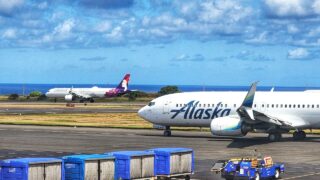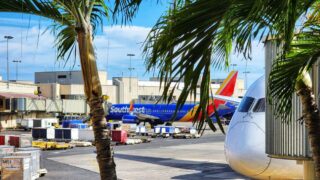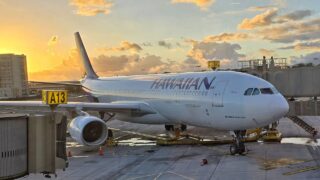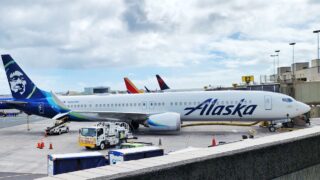While Alaska Airlines passengers literally slept on terminal floors Thursday night, Hawaiian Airlines kept flying to Hawaii as if nothing had happened. The difference? Hawaiian still runs on its own systems. That, however, is about to change.
Thousands of Hawaii-bound travelers were stranded when Alaska Airlines issued a nationwide ground stop due to a failure at its primary data center. Flights froze from Hawaii to Seattle to San Diego and across the country, terminals filled with frustrated passengers, and the carrier canceled operations for the night. Yet Hawaiian Airlines, now owned by Alaska Air, continued flying smoothly by all measures, a rare moment when distance still translated into momentary safety.
Alaska’s problems began around 12:30 p.m. Hawaii time when its primary data center failed. “The IT outage has impacted several of our key systems that enable us to run various operations, necessitating the implementation of the ground stop to keep our aircraft in position,” the company said, adding that safety was never compromised.
About five hours later, Alaska reported that operations had been restored. By the end of the day, FlightAware showed 158 canceled flights and 221 delayed.
As of Friday at 1:00 a.m. Hawaii time, another 113 flights had already been canceled and 24 were delayed on Alaska’s Friday schedule. The airline said that “additional flight disruptions are likely as we reposition aircraft and crews throughout our network.” It was not possible to reach Alaska by phone, and passengers reported hold times lasting up to five hours. It was nonetheless reported that Alaska was accommodating passengers via hotels and trying to leverage its Hawaiian Air capabilities as well.
Alaska went dark, but Hawaiian Airlines did not.
Still, every Alaska and Horizon Air flight went completely dark for hours as the airlines worked to restore operations. The airline later canceled all remaining departures and offered flexible rebooking through Monday. It’s hard to know just how this will shake out, but we will have personal experience to share come Friday morning.
For travelers headed to Hawaii on Alaska but not Hawaiian, that meant lost nights and money. People started emailing us after spending hours on the floor at Seattle waiting for word on their Maui connections. Hawaiian’s departures, however, took off right on time.
Hawaii travelers caught in the middle, again.
Alaska has built deep ties to the islands over the past two decades, offering frequent service that helps keep prices competitive. When its systems collapse, Hawaii feels it immediately. Especially now.
As one hotel manager told us late Thursday, “This is exactly why we always worry about connectivity. When one airline sneezes, Hawaii catches the cold. There aren’t enough backups.”
Hundreds of hotel rooms across the state remained unoccupied Thursday night, costing travelers anywhere from $300 to $500 or more per room. We’re hearing reports of prepaid car rental reservation issues, and one family told us they estimate losing $2,400.
Hawaiian’s continued flights provided a lifeline, but only because its infrastructure remains separate for now.
Alaska’s second breakdown this year signals what Hawaii flyers face.
Thursday’s outage was Alaska’s second major technology failure in less than a year. A July incident grounded all flights for hours, and the company claimed its issues had been fixed. It appears, however, that they were not.
The same day as the outage, Alaska Air Group released quarterly results that missed Wall Street expectations. Executives had already cited the July IT outage and weather as factors that hurt third-quarter performance. Now, another massive breakdown underscored just how fragile the airline’s systems remain.
Hawaiian produced a net operating loss according to Alaska. The company said that its “goal is in the long run of course to get Hawaiian back to sustainable profitability.” In the meantime Alaska faces the final push to integrate Hawaiian, including a single operating certification anticipated in the days ahead. Even more telltale will be the negotiation of union agreements for pilots and flight attendants, and the move to bring Hawaiian onto Alaska’s all-important passenger service system, also still pending. Yesterday’s earnings call which was to shed more light on the subject of Hawaiian’s integration was postponed due to the airline’s meltdown.
For passengers, corporate explanations about data centers and even quarterly financial results do not matter. What matters are the vacation time, hotel nights, and events missed, and the growing uncertainty of relying so much on this one company to keep Hawaii connected to the world.
Independence may have saved Hawaiian for today, but not forever.
Hawaiian confirmed Thursday that its operations were not affected because it still runs on its own technology. That includes separate servers and separate reservation systems. That wall kept the lights on in Honolulu while Alaska went dark.
But integration is coming fast. Alaska executives have already outlined plans to combine crew management and booking platforms. When that happens, Hawaiian’s ability to stay independent in a crisis will disappear entirely.
For Hawaii, that is not a small concern. The islands rely on consistent air access for both residents and visitors. A shared failure could one day cut off more than convenience; it could disrupt the state’s entire economic lifeline.
The hidden cost to travelers.
For many, Thursday’s disruption was not merely an inconvenience. It came with real costs. One traveler wrote that her expensive Maui hotel was non-refundable. Others scrambled to rebook at nose-bleed last-minute prices on Hawaiian, Southwest, or United.
Under federal rules, passengers can request full refunds for cancellations within the airline’s control, but those refunds do not cover lost reservations or missed days on the islands. That is the quiet damage an IT failure leaves behind. And that only trip insurance can cover.
What travelers should do now.
For anyone booking Hawaii trips in the coming weeks, including us, Thursday’s outage is a warning. Once Hawaiian and Alaska share systems, neither will be immune. That means building in buffer days on each side of a trip (something we did by overnighting in Los Angeles tonight), considering travel insurance that covers such airline failures, and avoiding tight connections whenever possible.
Hawaiian’s current reliability may itself not survive integration. Travelers who have come to trust it as the dependable Hawaii carrier could find themselves facing the same mainland fragility they once avoided.
The risk no one is talking about yet.
By late Thursday night, Alaska said it was restoring operations, but delays and cancellations were expected into Friday or beyond. Meanwhile, engineers were still investigating the cause.
Perhaps for one last time, Hawaiian’s independence saved it. Once systems merge, one data center failure could ground flights across the Pacific and on the mainland. Hawaii’s access to the world depends on an airline network increasingly controlled by a single company’s technology that is based in the Pacific Northwest.
Beat of Hawaii editors are flying Hawaiian Airlines across the Pacific early Friday morning and will report firsthand on how operations look after Alaska’s nationwide shutdown. For Hawaii, this was a lucky escape.
How much confidence do you still have in Hawaiian now that Alaska owns it, and do you worry future system failures could leave Hawaii travelers stranded, too?
Get Breaking Hawaii Travel News







Can you imagine what’s going to happen in April, when their computer systems are scheduled to merge? It’s chaotic now, trying to navigate between systems. We flew back to ITO from HNL on Tuesday. We had 2 confirmation numbers. We asked which one to use, the answer was, try both, one of them will work. We asked why we were reduced in loyalty status. No one could answer. HAL employees are just as frustrated as customers, having no answers.
Alaska Airlines is a joke. They’ll never be able to compete with the Big 3 like they dream of. Unless you live in the Pacific Northwest or Alaska there’s literally Zero reasons to choose them over one of the Big 3. Especially since the others have copied Alaska and now offer free alcohol in extra legroom.
I have been flying Hawaiian Air to Hawaii every year for 15+ years. Occasional delays but nothing costly or unmanageable. I was Very disappointed to read about Hawaiian being bought by Alaska. I hope these problems are not the tip of the iceberg.
The lesson here is 2 fold.
Always have travel insurance. (If you travel much at all, an annual travel insurance policy is a no brainer)
Never do prepaid car rentals or hotels to save a couple of bucks unless they are refundable (which is rare).
Didn’t the same thing happen to Hawaiian a few years back?
Hopefully you’re not trying to defend Alaska and the issues they bring to the table with this takeover. Going forward take the high road and stay away from both carriers until well into next year. There still are many other options out there.